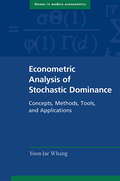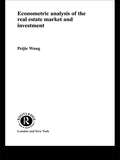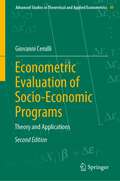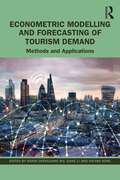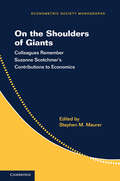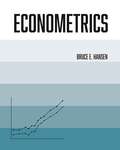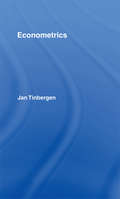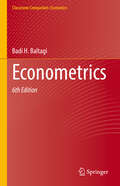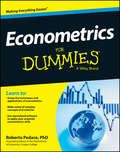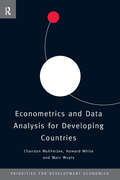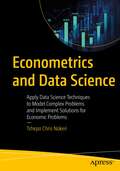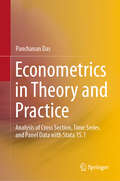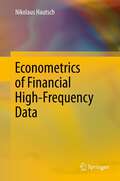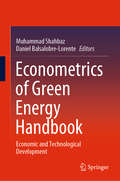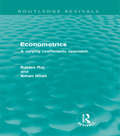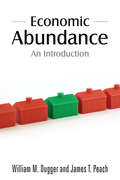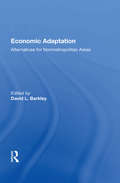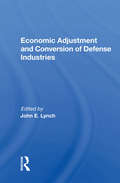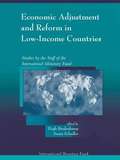- Table View
- List View
Econometric Analysis of Stochastic Dominance: Concepts, Methods, Tools, and Applications (Themes in Modern Econometrics)
by Yoon-Jae WhangThis book offers an up-to-date, comprehensive coverage of stochastic dominance and its related concepts in a unified framework. <P><P>A method for ordering probability distributions, stochastic dominance has grown in importance recently as a way to measure comparisons in welfare economics, inequality studies, health economics, insurance wages, and trade patterns. <P><P>Whang pays particular attention to inferential methods and applications, citing and summarizing various empirical studies in order to relate the econometric methods with real applications and using computer codes to enable the practical implementation of these methods. <P><P>Intuitive explanations throughout the book ensure that readers understand the basic technical tools of stochastic dominance.
Econometric Analysis of the Real Estate Market and Investment (Routledge Studies in Business Organizations and Networks)
by Peijie WangThis book provides an economic and econometric analysis of real estate investment and real estate market behaviour. Peijie Wang examines fluctuations in the real estate business to reveal the mechanisms governing the interactions between the industry and other sectors of the economy.
Econometric Evaluation of Socio-Economic Programs: Theory and Applications (Advanced Studies in Theoretical and Applied Econometrics #49)
by Giovanni CerulliThis book provides advanced theoretical and applied tools for the implementation of modern micro-econometric techniques in evidence-based program evaluation for the social sciences. The author presents a comprehensive toolbox for designing rigorous and effective ex-post program evaluation using the statistical software package Stata. For each method, a statistical presentation is developed, followed by a practical estimation of the treatment effects. By using both real and simulated data, readers will become familiar with evaluation techniques, such as regression-adjustment, matching, difference-in-differences, instrumental-variables, regression-discontinuity-design, and synthetic control method, and are given practical guidelines for selecting and applying suitable methods for specific policy contexts.The second revised and extended edition features two new chapters on some recent development of difference-in-differences. Specifically, chapter 5 introduces advanced difference-in-differences methods when many times are available and treatment can be either time-varying or fixed at a specific time. Chapter 6 introduces the synthetic control method, a treatment effect estimation approach suitable when only one unit is treated. Both chapters present applications using the software Stata.
Econometric Model of India
by Ramgopal AgarwalaFirst Published in 1970. Routledge is an imprint of Taylor & Francis, an informa company.
Econometric Modelling and Forecasting of Tourism Demand: Methods and Applications
by Doris Chenguang WuThis insightful and timely volume provides a succinct, expert-led introduction to the latest developments in advanced econometric methodologies in the context of tourism demand modelling and forecasting. Written by a plethora of worldwide experts on this topic, this book offers a comprehensive approach to tourism econometrics. Accurate demand forecasts are crucial to decision-making in the tourism industry and this book provides real-life tourism applications and the corresponding R code alongside theoretical foundations, in order to enhance understanding and practice amongst its readers. The methodologies introduced include general to specific modelling, cointegration, vector autoregression, time-varying parameter modelling, spatiotemporal econometric models, mixed-frequency forecasting, hybrid forecasting models, forecasting combination techniques, density forecasting, judgemental forecasting, scenario forecasting under crisis, and web-based tourism forecasting. Embellished with insightful figures and tables throughout, this book is an invaluable resource for those using advanced econometric methodologies in their studies and research, including both undergraduate and postgraduate students, researchers, and practitioners.
Econometric Society Monographs: Colleagues Remember Suzanne Scotchmer's Contributions to Economics (Econometric Society Monographs #57)
by Stephen M. MaurerThis book presents eleven classic papers by the late Professor Suzanne Scotchmer with introductions by leading economists and legal scholars. This book introduces Scotchmer's life and work; analyses her pioneering contributions to the economics of patents and innovation incentives, with a special focus on the modern theory of cumulative innovation; and describes her pioneering work on law and economics, evolutionary game theory, and general equilibrium/club theory. This book also provides a self-contained introduction to students who want to learn more about the various fields that Professor Scotchmer worked in, with a particular focus on patent incentives and cumulative innovation.
Econometrics
by Bruce HansenEconometrics is the quantitative language of economic theory, analysis, and empirical work, and it has become a cornerstone of graduate economics programs. Econometrics provides graduate and PhD students with an essential introduction to this foundational subject in economics and serves as an invaluable reference for researchers and practitioners. This comprehensive textbook teaches fundamental concepts, emphasizes modern, real-world applications, and gives students an intuitive understanding of econometrics. Covers the full breadth of econometric theory and methods with mathematical rigor while emphasizing intuitive explanations that are accessible to students of all backgrounds Draws on integrated, research-level datasets, provided on an accompanying website Discusses linear econometrics, time series, panel data, nonparametric methods, nonlinear econometric models, and modern machine learning Features hundreds of exercises that enable students to learn by doing Includes in-depth appendices on matrix algebra and useful inequalities and a wealth of real-world examples Can serve as a core textbook for a first-year PhD course in econometrics and as a follow-up to Bruce E. Hansen’s Probability and Statistics for Economists
Econometrics
by Fumio HayashiThe most authoritative and comprehensive synthesis of modern econometrics availableEconometrics provides first-year graduate students with a thoroughly modern introduction to the subject, covering all the standard material necessary for understanding the principal techniques of econometrics, from ordinary least squares through cointegration. The book is distinctive in developing both time-series and cross-section analysis fully, giving readers a unified framework for understanding and integrating results.Econometrics covers all the important topics in a succinct manner. All the estimation techniques that could possibly be taught in a first-year graduate course, except maximum likelihood, are treated as special cases of GMM (generalized methods of moments). Maximum likelihood estimators for a variety of models, such as probit and tobit, are collected in a separate chapter. This arrangement enables students to learn various estimation techniques in an efficient way. Virtually all the chapters include empirical applications drawn from labor economics, industrial organization, domestic and international finance, and macroeconomics. These empirical exercises provide students with hands-on experience applying the techniques covered. The exposition is rigorous yet accessible, requiring a working knowledge of very basic linear algebra and probability theory. All the results are stated as propositions so that students can see the points of the discussion and also the conditions under which those results hold. Most propositions are proved in the text.For students who intend to write a thesis on applied topics, the empirical applications in Econometrics are an excellent way to learn how to conduct empirical research. For theoretically inclined students, the no-compromise treatment of basic techniques is an ideal preparation for more advanced theory courses.
Econometrics
by Jan TinbergenOriginally published in 1951, this volume reprints the classic work written by one of the leading global econometricians.Econometrics is structured as followed:Part 1 explains the relationship of Econometrics to Economics and Statistics.Part 2 outlines the process of formulating economic hypotheses mathematically and of subjecting them to a statistical test.Part 3 deals with the various component equations of the economic system - the psychic reactions, technical relations and reactions of business life and describes the process of setting up an economic model of the system as a whole.Part 4 llustrates the use of econometric methods for policy purposes.
Econometrics
by K. Nirmal KumarThis book harbors an updated and standard material on the various aspects of Econometrics. It covers both fundamental and applied aspects and is intended to serve as a basis for a course in Econometrics and attempts at satisfying a need of postgraduate and doctoral students of Economics. It is hoped that, this book will also be worthwhile to teachers, researchers, professionals etc. Note: T& F does not sell or distribute the Hardback in India, Pakistan, Nepal, Bhutan, Bangladesh and Sri Lanka.
Econometrics (Classroom Companion: Economics)
by Badi H. BaltagiThis textbook teaches some of the basic econometric methods and the underlying assumptions behind them. It also includes a simple and concise treatment of more advanced topics in spatial correlation, panel data, limited dependent variables, regression diagnostics, specification testing and time series analysis. Each chapter has a set of theoretical exercises as well as empirical illustrations using real economic applications. These empirical exercises usually replicate a published article using Stata, Eviews as well as SAS.This new sixth edition has been fully revised and updated, and includes new material on limited dependent variables and panel data as well as revision of basic topics like heteroskedasticity, endogeneity, over-identification and specification testing. The author also provides more exercises and empirical examples based on published economic applications.
Econometrics For Dummies
by Roberto PedaceScore your highest in econometrics? Easy.Econometrics can prove challenging for many students unfamiliar with the terms and concepts discussed in a typical econometrics course. Econometrics For Dummies eliminates that confusion with easy-to-understand explanations of important topics in the study of economics.Econometrics For Dummies breaks down this complex subject and provides you with an easy-to-follow course supplement to further refine your understanding of how econometrics works and how it can be applied in real-world situations.An excellent resource for anyone participating in a college or graduate level econometrics courseProvides you with an easy-to-follow introduction to the techniques and applications of econometricsHelps you score high on exam dayIf you're seeking a degree in economics and looking for a plain-English guide to this often-intimidating course, Econometrics For Dummies has you covered.
Econometrics and Data Analysis for Developing Countries (Priorities for Development Economics)
by Howard White Chandan Mukherjee Marc WuytsGetting accurate data on less developed countries has created great problems for studying these areas. Yet until recently students of development economics have relied on standard econometrics texts, which assume a Western context. Econometrics and Data Analysis for Developing Countries solves this problem. It will be essential reading for all advanced students of development economics.
Econometrics and Data Science: Apply Data Science Techniques to Model Complex Problems and Implement Solutions for Economic Problems
by Tshepo Chris NokeriGet up to speed on the application of machine learning approaches in macroeconomic research. This book brings together economics and data science.Author Tshepo Chris Nokeri begins by introducing you to covariance analysis, correlation analysis, cross-validation, hyperparameter optimization, regression analysis, and residual analysis. In addition, he presents an approach to contend with multi-collinearity. He then debunks a time series model recognized as the additive model. He reveals a technique for binarizing an economic feature to perform classification analysis using logistic regression. He brings in the Hidden Markov Model, used to discover hidden patterns and growth in the world economy. The author demonstrates unsupervised machine learning techniques such as principal component analysis and cluster analysis. Key deep learning concepts and ways of structuring artificial neural networks are explored along with training them and assessing their performance. The Monte Carlo simulation technique is applied to stimulate the purchasing power of money in an economy. Lastly, the Structural Equation Model (SEM) is considered to integrate correlation analysis, factor analysis, multivariate analysis, causal analysis, and path analysis.After reading this book, you should be able to recognize the connection between econometrics and data science. You will know how to apply a machine learning approach to modeling complex economic problems and others beyond this book. You will know how to circumvent and enhance model performance, together with the practical implications of a machine learning approach in econometrics, and you will be able to deal with pressing economic problems. What You Will LearnExamine complex, multivariate, linear-causal structures through the path and structural analysis technique, including non-linearity and hidden statesBe familiar with practical applications of machine learning and deep learning in econometricsUnderstand theoretical framework and hypothesis development, and techniques for selecting appropriate modelsDevelop, test, validate, and improve key supervised (i.e., regression and classification) and unsupervised (i.e., dimension reduction and cluster analysis) machine learning models, alongside neural networks, Markov, and SEM modelsRepresent and interpret data and models Who This Book Is ForBeginning and intermediate data scientists, economists, machine learning engineers, statisticians, and business executives
Econometrics in Theory and Practice: Analysis of Cross Section, Time Series and Panel Data with Stata 15.1
by Panchanan DasThis book introduces econometric analysis of cross section, time series and panel data with the application of statistical software. It serves as a basic text for those who wish to learn and apply econometric analysis in empirical research. The level of presentation is as simple as possible to make it useful for undergraduates as well as graduate students. It contains several examples with real data and Stata programmes and interpretation of the results. While discussing the statistical tools needed to understand empirical economic research, the book attempts to provide a balance between theory and applied research. Various concepts and techniques of econometric analysis are supported by carefully developed examples with the use of statistical software package, Stata 15.1, and assumes that the reader is somewhat familiar with the Strata software. The topics covered in this book are divided into four parts. Part I discusses introductory econometric methods for data analysis that economists and other social scientists use to estimate the economic and social relationships, and to test hypotheses about them, using real-world data. There are five chapters in this part covering the data management issues, details of linear regression models, the related problems due to violation of the classical assumptions. Part II discusses some advanced topics used frequently in empirical research with cross section data. In its three chapters, this part includes some specific problems of regression analysis. Part III deals with time series econometric analysis. It covers intensively both the univariate and multivariate time series econometric models and their applications with software programming in six chapters. Part IV takes care of panel data analysis in four chapters. Different aspects of fixed effects and random effects are discussed here. Panel data analysis has been extended by taking dynamic panel data models which are most suitable for macroeconomic research. The book is invaluable for students and researchers of social sciences, business, management, operations research, engineering, and applied mathematics.
Econometrics of Financial High-Frequency Data
by Nikolaus HautschThe availability of financial data recorded on high-frequency level has inspired a research area which over the last decade emerged to a major area in econometrics and statistics. The growing popularity of high-frequency econometrics is driven by technological progress in trading systems and an increasing importance of intraday trading, liquidity risk, optimal order placement as well as high-frequency volatility. This book provides a state-of-the art overview on the major approaches in high-frequency econometrics, including univariate and multivariate autoregressive conditional mean approaches for different types of high-frequency variables, intensity-based approaches for financial point processes and dynamic factor models. It discusses implementation details, provides insights into properties of high-frequency data as well as institutional settings and presents applications to volatility and liquidity estimation, order book modelling and market microstructure analysis.
Econometrics of Green Energy Handbook: Economic and Technological Development
by Muhammad Shahbaz Daniel Balsalobre-LorenteThis book gathers cutting-edge studies on the relationship between energy innovations, economic growth, environmental regulation, promotion of renewable energy use, and climate change. Building on the research discussed in the editor’s previous book Decarbonization and Energy Technology in the Era of Globalization, it discusses recent developments such as the impacts of globalization and energy efficiency on economic growth and environmental quality. It also explores the ways in which globalization has benefited green energy development, e.g. the expansion of new technologies and cleaner machinery, as well as the problems it has caused. Written by respected experts, the respective contributions address topics including econometric modelling of the behaviour of and dynamics between economic growth and environmental quality, aspects of energy production and consumption, oil prices, economic growth, trade openness, environmental quality, regulatory measures, and innovations in the energy sector. Providing a comprehensive overview of the latest research, the book offers a valuable reference guide for researchers, policymakers, practitioners and students in the fields of renewable energy development and economics.
Econometrics of Risk
by Van-Nam Huynh Vladik Kreinovich Songsak Sriboonchitta Komsan SuriyaThis edited book contains several state-of-the-art papers devoted to econometrics of risk. Some papers provide theoretical analysis of the corresponding mathematical, statistical, computational, and economical models. Other papers describe applications of the novel risk-related econometric techniques to real-life economic situations. The book presents new methods developed just recently, in particular, methods using non-Gaussian heavy-tailed distributions, methods using non-Gaussian copulas to properly take into account dependence between different quantities, methods taking into account imprecise ("fuzzy") expert knowledge, and many other innovative techniques. This versatile volume helps practitioners to learn how to apply new techniques of econometrics of risk, and researchers to further improve the existing models and to come up with new ideas on how to best take into account economic risks.
Econometrics: A Varying Coefficients Approach (Routledge Revivals)
by Baldev Raj Aman UllahOriginally published in 1981, this book considers one particular area of econometrics- the linear model- where significant recent advances have been made. It considers both single and multiequation models with varying co-efficients, explains the various theories and techniques connected with these and goes on to describe the various applications of the models. Whilst the detailed explanation of the models will interest primarily econometrics specialists, the implications of the advances outlined and the applications of the models will intrest a wide range of economists.
Economic & Philosophic Manuscripts of 1844
by Karl MarxThese early writings of Marx throw new light upon the origins and formative period of Marxism. Major emphasis is on alienation of the laborer in capitalist society.
Economic Abundance: An Introduction
by William M. Dugger James T. PeachMost principles of economics texts are predicated narrowly on the concept of scarcity as a fundamental force, but that is only one aspect of economics. This supplemental text for basic and intermediate level undergraduates provides a serious discussion of the concept of abundance - what it means, how we can move toward it, and what keeps us from doing so. The authors first outline the development of the concept of abundance and its meaning with discussions of the roles of population, resources, and the environment. Then they consider why abundance escapes us, focusing on the detrimental roles of four predatory behaviors - classism, nationalism, sexism, and racism. As a remedy, they propose a policy of universal employment as a replacement for full employment, and explore the effects of pushing the unemployment rate down to absolute zero.
Economic Accounting: Accounting: Economic Accounting (Routledge Library Editions: Accounting)
by Diran BodenhornDivided into three parts this volume discusses the Crusoe model of accounting, and a model appropriate for the Crusoe model. It also considers some accounting problems which arise in the real world as well as a discussion of government and business accounting, along with money, banks and financial institutions.
Economic Adaptation: Alternatives For Nonmetropolitan Areas
by David L BarkleyThis volume focuses on alternatives for non-metropolitan economic development in the new international economic climate. It provides critical reviews of popular employment-generation alternatives for rural areas.
Economic Adjustment And Conversion Of Defense Industries
by John E. LynchDefense plant cutbacks and military base closures have affected hundreds of U.S. communities during the past twenty-five years. Tracing the recovery of four communities after large defense plant cutbacks and of one hundred communities after military base closures, the contributors analyze the transition from the production of military to civilian goods. The contributors examine the market potential of reusing defense industrial plants to produce civilian products within the one- to two-year period called for by economic conversion proponents, showing that the complex process needed to develop, test, and market an entirely new product requires a minimum of five years. They also review the wide range of economic development techniques available at the state and local level, conversion approaches in Western Europe, programs for displaced workers, and reasons why the economic conversion approach has failed to attract public support in the United States. The case studies are used to formulate an integrated, composite approach for coping with plant closures and major employment dislocations. Stressing the in portance of community-based economic adjustment activities, this book will be valuable to all concerned with mitigating the effects of military and civilian plant closures.
Economic Adjustment and Reform in Low-Income Countries
by Susan Schadler Hugh BredenkampEconomic Adjustment and Reform in Low-Income Countries. Includes bibliographical references.
